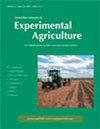Designing complex research projects to estimate genetic parameters plus treatment and other effects – optimising the experimental design
引用次数: 2
Abstract
There is an increasing trend towards integrated research, in which several individuals or institutions pool their expertise and make use of common resources, collaborating towards a common set of scientific goals. Integrated research enables a larger number of factors to be investigated, and the most influential or important ones identified, providing information on how the different factors interact or fit together. Good experimental design is, however, required to ensure the aims can be achieved and resources spent wisely. Issues involved in the experimental design of the Australian Beef Cattle Cooperative Research Centre for Meat Quality are discussed. Theoretical results and simulation studies were used to determine optimal numbers of progeny per sire for estimating genetic parameters. For heritabilities of 0.2 and 0.5, the optima are respectively 21 and 9 progeny with recorded measurements. The curves surrounding the optima are quite flat, so aiming for 10–15 progeny with measurements per trait should provide reasonable accuracy in many situations. Estimates of heritabilities, genetic correlations and phenotypic variances have lower sampling correlations than genetic variances and covariances, suggesting that when results are pooled over different breeds or trials, it is better to pool estimates of heritabilities and genetic correlations than (co)variances. Using sires in more than one year increases the robustness of estimated sire effects and increases the accuracy of genetic parameter estimates for hard-to-measure traits (e.g. feed efficiency) that are not recorded on all animals. Unless sires can be chosen as a true random sample of the population, arrangements of link sires (and other effects such as treatments) should be chosen to provide accurate estimates when all terms in the model are fitted as fixed.设计复杂的研究项目来估计遗传参数加上治疗和其他影响——优化实验设计
综合研究的趋势正在增加,在这种趋势中,几个个人或机构汇集他们的专门知识并利用共同资源,为一套共同的科学目标而合作。综合研究能够调查更多的因素,并确定最具影响力或最重要的因素,提供关于不同因素如何相互作用或相互配合的信息。然而,需要良好的实验设计来确保目标的实现和资源的合理使用。讨论了澳大利亚肉牛肉质合作研究中心实验设计中涉及的问题。理论结果和模拟研究用于确定每一种品种的最佳子代数,以估计遗传参数。遗传力为0.2和0.5时,有记录的最优子代分别为21个和9个。围绕最优点的曲线是相当平坦的,因此在许多情况下,针对每个性状测量10-15个子代应该提供合理的精度。遗传力、遗传相关性和表型方差的估计值比遗传方差和协方差具有更低的抽样相关性,这表明当汇总不同品种或试验的结果时,汇总遗传力和遗传相关性估计值比(co)方差更好。在一年以上的时间内使用母猪增加了估计母猪效应的稳健性,并提高了对难以测量的性状(如饲料效率)的遗传参数估计的准确性,这些性状并非在所有动物身上都有记录。除非可以选择样本作为人口的真正随机样本,否则当模型中的所有项都被拟合为固定时,应该选择链接样本的安排(以及其他影响,如处理)来提供准确的估计。
本文章由计算机程序翻译,如有差异,请以英文原文为准。
求助全文
约1分钟内获得全文
求助全文

 求助内容:
求助内容: 应助结果提醒方式:
应助结果提醒方式:


